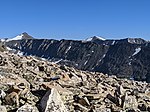Jacque Peak
Colorado geography stubsMountains of ColoradoMountains of Summit County, ColoradoNorth American 4000 m summitsWhite River National Forest

Jacque Peak is a high and prominent mountain summit in the Gore Range of the Rocky Mountains of North America. The 13,211-foot (4,027 m) thirteener is located in the White River National Forest, 1.6 miles (2.5 km) south by east (bearing 173°) of the resort community of Copper Mountain in Summit County, Colorado, United States.
Excerpt from the Wikipedia article Jacque Peak (License: CC BY-SA 3.0, Authors, Images).Jacque Peak
Geographical coordinates (GPS) Address Nearby Places Show on map
Geographical coordinates (GPS)
| Latitude | Longitude |
|---|---|
| N 39.4544315 ° | E -106.1975234 ° |
Address
Summit County (Summit)
Colorado, United States
Open on Google Maps








